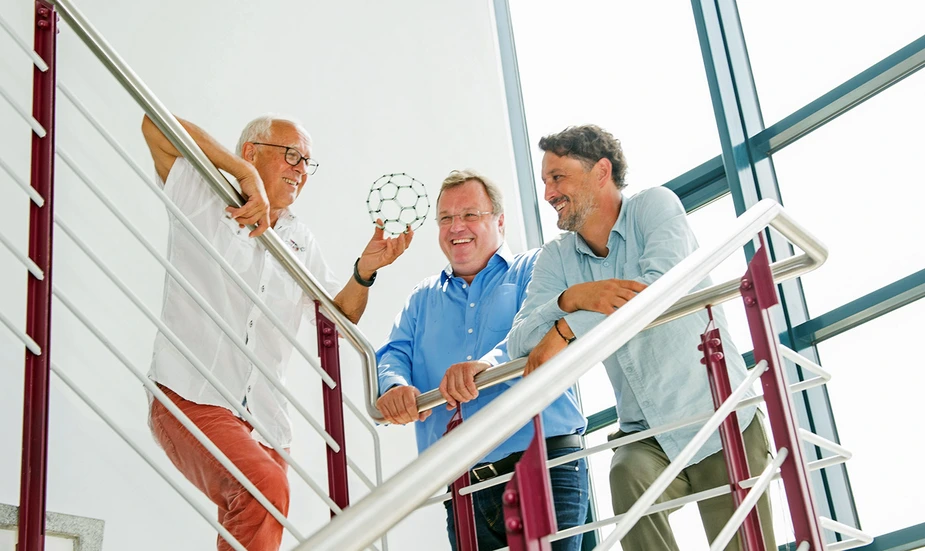Neighbourly cooperation and fluoride innovation
How a meeting at a cafeteria resulted in a project to improve fire safety
Sometimes all you need to advance potentially life-saving innovations is a lateral thinker, two specialists, and a random meet-up at the cafeteria. A typical story from Adlershof.
They had been working on various floors of the Adlershof of the Innovation and Business Incubation Centre (IGZ) for years. As innovation manager at Stöbich technology GmbH, Torsten Mehlhorn is specialised on advancing new technologies and thoroughly enjoys the freedom to experiment and try new things. A few floors further up, Frank von Heyden and Prof. Erhard Kemnitz work at nanofluor GmbH, a start-up producing nano-scale metal fluorides, a new material created through its patented sol–gel process. ‘We didn’t know each other a few months ago,’ they say.
Everything changed through a random meet-up at the cafeteria, where Kemnitz was eating with Prof. Wolfgang Rehak. ‘He’s a full-on networker, who has often shown interest in nanofluor and has many ideas for the application of nanoscopic fluorides,’ he says. Fire safety was one of those ideas. At first, Kemnitz did not take it all that seriously. Fire safety was not a target market for fluorides, which was focused on anti-reflective coating for glasses and lenses, remineralising toothpaste, as well as adhesives and varnish solutions. All these products had improved their mechanical and optical properties by using nanoscale fluorides. The young company has several irons in the fire and is cooperating with researchers and developers all over the globe. ‘Finding ways into the market is taking longer than we anticipated when we founded the company,’ says von Heyden. In technical departments, nanofluour is all the rage. However, it takes considerable staying power and good contacts to convince the top-level decision makers.
Rehak saw his friend Torsten Mehlhorn at said cafeteria and knew he was working on something related to fire safety. He pointed out that Mehlhorn was somebody worth talking to and introduced his acquaintances to each other. ‘When I heard that fluorides bind to atoms twice as strong as oxygen, that’s when I really started listening,’ Mehlhorn remembers. In fire safety, a material capable of fending off the threat of oxygenation, the saturation of textiles with oxygen, resembles a hole-in-one.
Rehak, the above-mentioned lateral thinker, was responsible for bringing the two specialists together. The benefits of the Adlershof community made sure that the idea was developed before going back into hibernation. ‘We went to the nanofluor lab, sprayed nano fluorides on fire safety textiles and materials, and simply fired the Bunsen burner at them,’ says Kemnitz. The result was staggering. Some of the textiles braved the flames up to five times longer than those without nano coating. They followed these experiments up with More tests under standard conditions and drew up a proof of concept. At first attempt, the nanoscale fluoride coating increased the resilience of fiberglass-based fire safety textiles by 50%.
‘According to German fire resistance standards, a material certified T120 must have a resistance duration of 120 minutes at 1.200 degrees Celsius,’ says Mehlhorn. ‘If we were able to push this to 180 minutes using nanocoating, this were a major improvement.’ In a worst-case scenario, lowering textile partition walls could protect buildings, such as exhibition centres, factories, or airports, against rapidly spreading fires. This facilitates light, large and fire-safe architecture. ‘The next step is nanocoating on a square-kilometre scale,’ says the fire expert. Tests to that effect are already underway. The business founders are currently exploring the integration of nanoscale fluorides into the original textile to replace subsequent coating. ‘We are still looking for the best configuration, but we are making very good progress,’ says Kemnitz. The fact that they are neighbours is a huge advantage. Neighbourly cooperation leading to fluoride innovation – this is typical for Adlershof.
By Peter Trechow for Adlershof Journal
